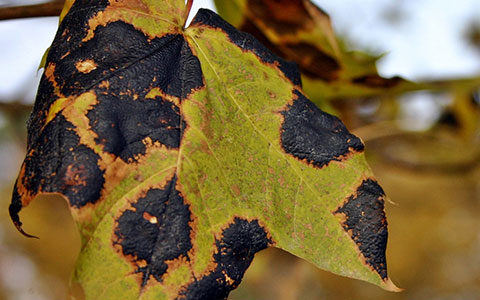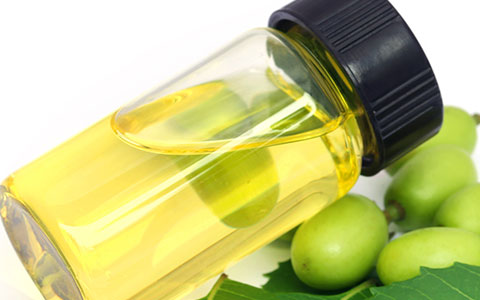
Prevent anthracnose from harming your trees, shrubs, and turf, causing their decline and eventual death. By knowing how to identify this pesky fungal disease, you can take steps to control and prevent it.
72tree.com gathered information to help you identify the symptoms of anthracnose, what it infects, how to treat it, and how to prevent the disease.
What Is Anthracnose
Anthracnose is the name given to a group of fungal pathogens that attack a wide variety of herbaceous and woody plants in spring with cool and wet weather. Fungi overwinter (lie dormant) in dead twigs and fallen leaves. Cool, rainy weather provides perfect conditions for emerging spores to spread.
Anthracnose Symptoms
Anthracnose symptoms can appear differently depending on what part of a plant or tree it has infected. The following will help you positively identify an anthracnose infection:
Twig, Branch, and Stem/Trunk Symptoms – Anthracnose infections on twigs most commonly appear as small orange-brown blisters or as a brown band encircling and girdling the young twig resulting in shoot death.
In more advanced cases, anthracnose can cause open wounds on branches, stems, and trunks. These open wounds typically appear sunken, dark, and wet.

Leaf Symptoms – Tan to dark brown irregular shaped blotches develop on young leaves, and they are typically distorted, cupped, or curled. When there is a severe anthracnose infection, premature leaf drop can occur in spring. When this happens, trees will usually produce a second growth of foliage by midsummer.
An anthracnose infection may cause identical spots on mature leaves. Still, these leaves generally do not portray the cupped or distorted appearance. These spots on mature leaves are frequently accompanied by minor wounds from insect feeding.
For trees, these symptoms are typically most severe on lower and inner branches but can travel up through the entire canopy.
Fruit Symptoms – Anthracnose fruit rot is identified as brown to black, water-soaked, sunken spots on green and ripe fruit. These lesions can develop over time, depending on weather conditions during disease development.
Grass/Turf Symptoms – Anthracnose diseases are common and destructive problems in landscapes and golf course greens with creeping bentgrass or annual bluegrass.
Anthracnose may develop in grasses as a foliar blight, in which grass leaves are infected, or a basal rot, attacking leaf sheaths, crowns, and stolons.
Anthracnose symptoms in grass and turf can be highly variable. Consider the following:
•Yellow to orange spots in irregular patterns
•Small freckle-like spots
•Circular patches reaching a foot in diameter
Symptoms are typically most severe in areas that are stressed from low mowing, excessive traffic, or inadequate irrigation or fertilization.
These symptoms first appear on the oldest growth, which dies back from the tip. The disease then gradually progresses to the younger leaves.
As the disease progresses from the foliage to basal rot, the leaf sheaths, crowns, and stolons will be darkened and rotten.
Tip: Use a magnifying glass to identify acervuli. These black, saucer-shaped pads with protruding black spines (setae) are the disease’s reproductive structures filled with spores.
Anthracnose Disease Cycle
An anthracnose disease cycle starts when a host is infected in spring or early summer from spores in fallen leaves, infected twigs/limbs, and lesions called cankers. Leaf infections commonly progress to stem and bud infections where the pathogen continues to grow and cause dieback.
Dieback is frequently the result of cankers growing over multiple years and, unless treated, will result in hydraulic failure to foliage, the decline in health, and vulnerability to deadly pathogens and/or infestations.

Generally, anthracnose infections are not lethal to plants and trees. But, if the pathogen is left to flourish for multiple growing seasons, it will weaken its host, allowing other diseases or insects to successfully attack and kill it.
Anthracnose Treatment
Due to the ease in which anthracnose spreads and infects plant life, once identified, fast action is required to prevent a wide-spread, severe outbreak. The following will help you reduce transmission of the pathogen:
•Apply a broad-spectrum, non-toxic bio-fungicide safe for organic use directly on and around infected areas
•Halt all overhead watering practices and install drip lines where possible
•Carefully prune and destroy all infected foliage, stems, and branches
•Collect and destroy fallen leaves, twigs, and debris from beneath infected trees, shrubs, and plants throughout the growing season and summer months
•Sanitize all pruning and gardening equipment after each use with a one part bleach to 4 parts water solution
•Call a professional tree service to treat cankers on tree trunks (tree removal may be required in more severe stages of infection)
•Do not walk through or work on your garden, lawn, or shrubs when they are wet
•Avoid composting infected foliage, fruit, cuttings, or stems
•Thoroughly clear debris from gardens and from under shrubs and trees in the fall to reduce overwintering opportunities for fungal spores
Read more about treating and eliminating fungi at 72tree.com/how-to-get-rid-of-tree-fungi/
Anthracnose Prevention
While it can be challenging to prevent, the following measures will help you protect your garden, bushes, and trees from anthracnose:
•Use western grown seeds which have not been exposed to anthracnose
•Plant disease-resistant species when possible
•Water, fertilize, prune, and mulch your plants and trees to promote their health
•Apply liquid copper sprays weekly throughout the growing season
•Apply sulfur powders weekly throughout the growing season
•Apply neem oil at the first sign of budding, then weekly throughout the growing season
Note: Neem oil is an organic, multi-purpose fungicide, insecticide, and miticide eliminating all stages of insects while preventing fungal attacks.

Anthracnose Symptoms, Treatment, and Prevention
In this article, you discovered what anthracnose is, how to identify it, and measures to treat and prevent it from harming your landscape.
By taking swift action to halt the progression and prevent anthracnose infections, you are preserving the health of your grass, plants, shrubs, and trees.
Allowing anthracnose to spread without treatment will leave the plant life on your landscape in poor health and susceptible to more deadly pathogens and infestations.
Sources:
extension.umn.edu/plant-diseases/anthracnose-trees-and-shrubs
content.ces.ncsu.edu/anthracnose-in-turf
ipm.illinois.edu/diseases/series600/rpd621/index.html
missouribotanicalgarden.org/gardens-gardening/your-garden/help-for-the-home-gardener/advice-tips-resources/pests-and-problems/diseases/anthracnose.aspx